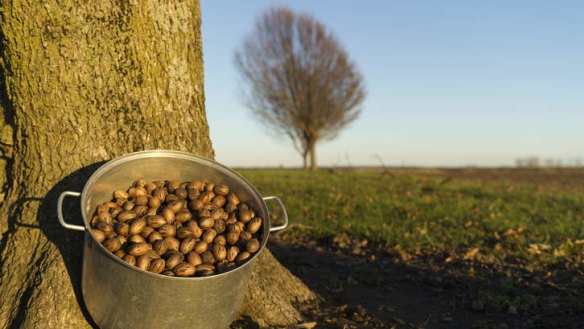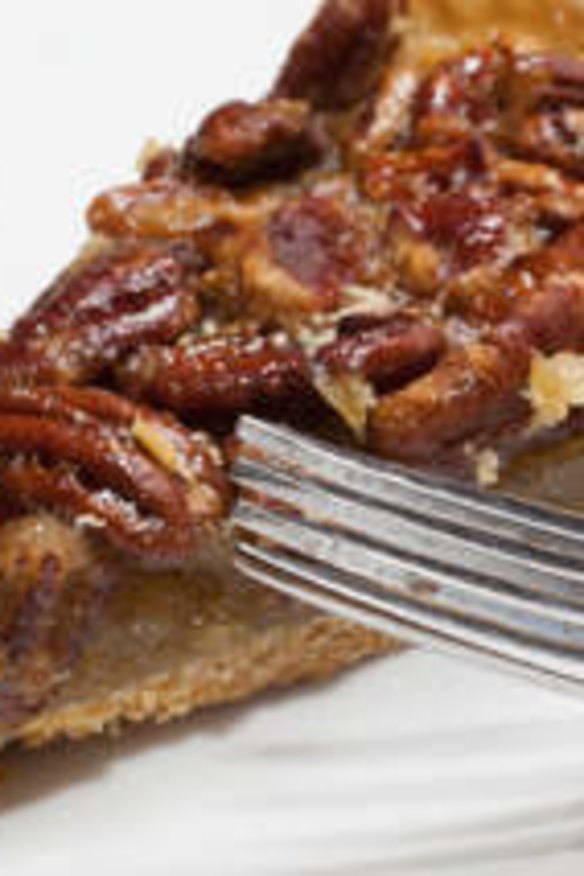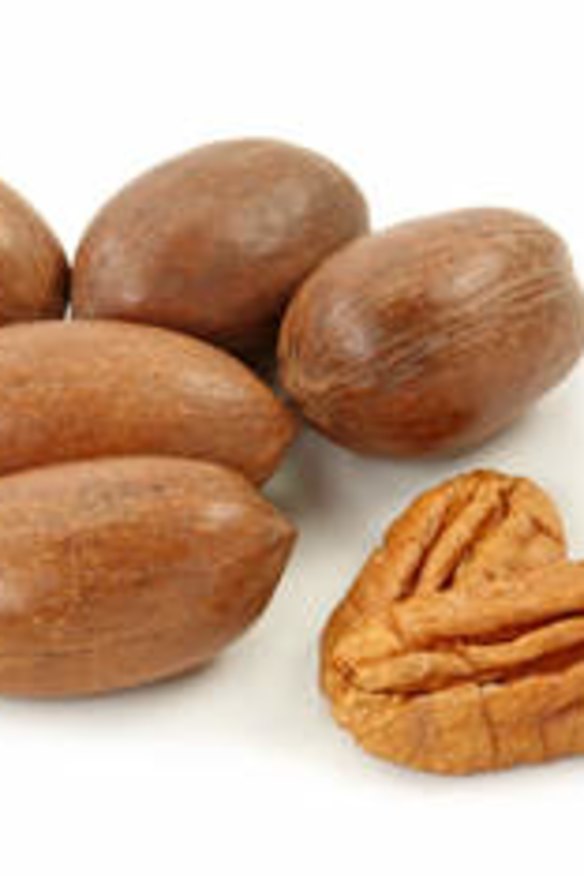Growing pecans in Canberra isn't nutty

Last Saturday I had a visitor asking me what nut trees could he plant in Canberra. Well, he came to someone who has tried to plant every possible nut tree, with mixed success. Almonds flower too early and the frosts seem to always nip the buds, so we have not gathered any crops and our early plantings of walnut trees have died.
However, one of the loveliest nut trees that can be grown is the pecan tree. It will grow into a large spreading tree, quite shapely in appearance with long, willowy branches and finely shaped leaves.
We did not plant pecans initially, preferring to plant an avenue of walnut trees along our driveway. Walnuts have a very deep tap root system and alas, we did not deep-rip our shaley soil alongside our driveway. So the 12 walnut trees struggled to grow and finally died.

Walnut trees need good drainage and the opportunity to penetrate deeply into the soil below. The best walnut tree I have seen growing in Canberra is near Bert Hauptmann's house at his Pialligo orchard in Beltana Road, growing in the alluvial soils close to the Molongo River.
We can see the difference in growing conditions when we visit our son Stephen and his family in Leeton. The newly established walnut grove on the eastern outskirts of Leeton is doing very well where the soil structure of the Murrumbidgee Irrigation Area is so different from our highlands-based soils.
Pecan trees are native to North America. Coming from the hot and dry parts of the continent they are suitable for our land. They have been grown in Australia for more than 150 years. They need to be able to send their roots down deep into the soil, so if you decide to plant a pecan tree you will need to allow plenty of space, remove any rocky substrata, ensure good drainage and show plenty of patience in the coming years. They can take up to 10 years to begin producing a reasonable crop of nuts. And when the crop is on the tree, it will need regular summer watering to fill out the nuts. In addition, remember that they are typically biennial, so you can only expect a big crop every second year - and that is only when we have a long hot summer. However, they are long lasting trees, very graceful in appearance and they will probably outlive your grandchildren.

As with most other nut trees, pecan trees produce both male and female flowers on the same tree. However, there is just a small window of reception with the female flower so effective fertilisation really needs two or three varieties where the male flower is available at the right time. This is a very similar story to that of cherry trees, so that a single tree will look beautiful but not yield much of a crop.
The male pecan flowers are produced on the previous year's wood, in the form of long stalky catkins. Female flowers are produced at the end of small shoots that have grown in the most recent season. And with the pollination being windborne, it is best to plant the primary pollinator on the north western side of the group of pecan trees, as that is the prevailing wind direction for Canberra.
Pecan trees need long warm to hot summers but also need some 600 plus chill hours during winter to properly set the flowers. From the last spring frost they need between 180 to 220 days of frost free weather to produce a mature nut (the time difference relates to the variety). The nut matures in late April and through the month of May, so you will have the case of leaves falling and nuts still hanging on the trees.
There are few problems with growing pecans, but their long growing season means that they are an easy target for birds, especially cockatoos. The biggest plantation of pecans is located in Moree and they have even resorted to using helicopters to chase the birds away.
Western Schley is the main variety planted in the commercial plantations to our north but this has a long maturing period, of around 230 days so is not really suitable for Canberra. Cheyenne is a high yielding variety with only 180-200 days for its growing season. It is a smaller tree than most pecans and it produces good quality, smallish sized nuts. It does require very regular waterings to fill out the nuts in late summer and autumn.
Cherokee is another high-producing variety with under 200 days in its growing season. Cherokee does produce large quantities of medium-sized nuts. If it is growing on fertile soils, it does require regular pruning. Shoshoni is another early maturing variety, producing a large nut. Tejas is the fourth suitable variety, with a short growing season. Its nuts are small in size but normally well filled. It acts as a good pollinator for Cherokee and Cheyenne.
Pecan pie
20g ground pecans
200g shortcrust pastry
75g pecan nuts, shelled
2 large free range eggs
100g brown sugar
50g maple syrup
250g golden syrup
½ tsp vanilla essence
Mix the ground pecans into the shortcrust pastry then roll it out. Line a shallow pie dish. Blind bake for 20 minutes at 190C, making sure to weigh the pastry down with rice.
Remove and allow to cool. Layer the shelled pecans onto the pastry. Beat the eggs and add in the brown sugar. When well mixed, add in the maple syrup, golden syrup and vanilla essence. Then carefully pour the mixture over the pecan nuts.
Bake at 220C for 10 minutes then reduce the heat to 180C and bake for another 30 minutes. Cool and place in the refrigerator for one hour before serving with thick cream.
This week in the garden
■ Plant broad beans, peas and shallots. Plant a small selection of open leaf lettuces in a sheltered, sunny location.
■ Consider purchasing and planting out some potted herbs including rosemary, thyme, chervil and a bay tree.
■ Complete the planting of garlic - if the cloves are planted much after mid-May, the colder conditions will limit the early establishment of a good healthy bulb.
■ This is the time to clean up the autumn leaves and begin to make a new compost heap for winter. Mix in green grass with the raked-up leaves and any kitchen scraps. Seek out a supply of animal manures from a local stable or add the contents of some bags of sheep manure or cow manure being sold at some local market.
■ If you have any dormant garden beds plant a green manure crop (rye, oats, mustard or broad beans) which you can dig back into the garden at winter's end.
■ Prune your peach, nectarine and plum trees. Cut back branches quite vigorously to reduce the overall height and minimise crowding.
>> Owen Pidgeon runs the Loriendale Organic Orchard near Hall.
The best recipes from Australia's leading chefs straight to your inbox.
Sign up